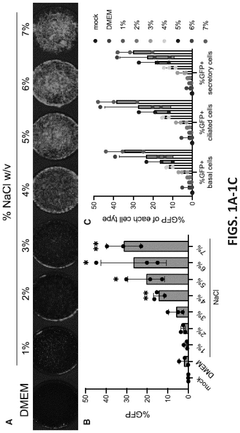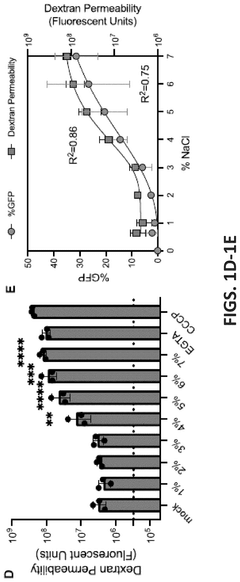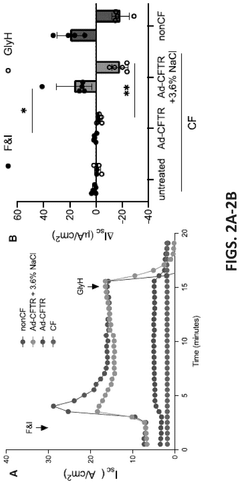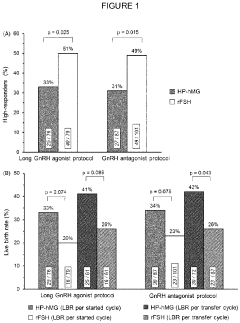How to Enhance Fertility Treatments with Hypertonic Solutions?
Fertility Enhancement Goals
Enhancing fertility treatments with hypertonic solutions represents a promising frontier in reproductive medicine. The primary goal is to improve the success rates of assisted reproductive technologies (ART) while minimizing invasive procedures and potential side effects. This approach aims to optimize the physiological conditions for embryo implantation and development, potentially increasing the chances of successful pregnancies.
One key objective is to develop hypertonic solutions that can create an ideal uterine environment for embryo transfer. These solutions are designed to mimic the natural osmotic conditions found during the implantation window, potentially enhancing the receptivity of the endometrium. By fine-tuning the osmolality of the uterine fluid, researchers aim to improve the attachment and invasion of the embryo into the uterine wall.
Another critical goal is to explore the use of hypertonic solutions in gamete preparation and embryo culture media. This involves investigating how controlled osmotic stress can potentially improve sperm motility, oocyte quality, and embryo development. The aim is to identify optimal concentrations and compositions of hypertonic solutions that can enhance the overall quality of gametes and embryos without causing cellular damage.
Researchers are also focusing on developing personalized fertility treatments using hypertonic solutions. This goal involves creating tailored approaches based on individual patient characteristics, such as age, hormonal profiles, and previous fertility treatment outcomes. By customizing the osmotic environment for each patient, clinicians hope to maximize the chances of successful conception and implantation.
Additionally, there is a strong emphasis on minimizing the risks associated with multiple pregnancies, a common concern in fertility treatments. Hypertonic solutions may play a role in improving single embryo transfer success rates, potentially reducing the need for multiple embryo transfers and the associated risks of multiple gestations.
Lastly, a significant goal is to integrate hypertonic solution-based treatments into existing ART protocols seamlessly. This involves developing standardized procedures for the preparation and application of these solutions, as well as establishing clear guidelines for their use in different stages of fertility treatment. The ultimate aim is to create a comprehensive, evidence-based approach that can be widely adopted in fertility clinics worldwide, potentially revolutionizing the field of reproductive medicine and offering new hope to individuals and couples struggling with infertility.
Market Analysis
The fertility treatment market has been experiencing significant growth in recent years, driven by factors such as increasing infertility rates, delayed parenthood, and advancements in reproductive technologies. The global fertility services market was valued at approximately $21 billion in 2020 and is projected to reach $41 billion by 2026, growing at a CAGR of 11.2% during the forecast period.
Within this expanding market, there is a growing interest in innovative approaches to enhance the success rates of fertility treatments. Hypertonic solutions have emerged as a promising area of research, offering potential benefits in various stages of assisted reproductive technologies (ART). The use of hypertonic solutions in fertility treatments is still in its early stages, but it has garnered attention from both researchers and clinicians due to its potential to improve outcomes.
The demand for enhanced fertility treatments is driven by several factors. Firstly, the success rates of current fertility treatments, while improving, still leave room for advancement. For instance, the live birth rate per embryo transfer for IVF treatments ranges from 20% to 40%, depending on various factors such as age and underlying fertility issues. This creates a significant opportunity for technologies that can improve these success rates.
Secondly, the emotional and financial costs associated with fertility treatments are substantial, motivating patients and healthcare providers to seek more effective solutions. The average cost of a single IVF cycle in the United States ranges from $12,000 to $15,000, not including medications. Techniques that can increase the likelihood of success per treatment cycle could potentially reduce the overall cost and emotional burden for patients.
Geographically, North America and Europe currently dominate the fertility services market, accounting for over 60% of the global market share. However, the Asia-Pacific region is expected to witness the highest growth rate in the coming years, driven by changing lifestyles, increasing awareness, and improving healthcare infrastructure.
The potential market for hypertonic solutions in fertility treatments extends beyond just IVF clinics. It could also include fertility preservation services, research institutions, and pharmaceutical companies developing reproductive health products. As the technology advances, there may be opportunities for at-home fertility enhancement products incorporating hypertonic solutions, further expanding the market reach.
However, it's important to note that the adoption of new technologies in the fertility treatment market is often gradual, requiring extensive clinical trials and regulatory approvals. The market for hypertonic solutions in fertility treatments will likely develop in phases, starting with research and clinical trials, followed by early adoption in specialized fertility clinics, and potentially expanding to wider use if proven effective and safe.
Hypertonic Solutions Status
Hypertonic solutions have gained significant attention in the field of fertility treatments due to their potential to enhance success rates. These solutions, characterized by higher solute concentrations compared to physiological fluids, are being explored for their ability to improve various aspects of assisted reproductive technologies.
Currently, hypertonic solutions are primarily utilized in cryopreservation processes for gametes and embryos. The high solute concentration in these solutions helps prevent intracellular ice formation during freezing, thereby protecting cellular structures and maintaining viability. This application has greatly improved the long-term storage capabilities of reproductive cells and tissues, enabling more flexible treatment schedules and increased options for patients.
In recent years, researchers have begun investigating the use of hypertonic solutions in other stages of fertility treatments. One promising area is the improvement of sperm motility and function. Studies have shown that exposure to carefully formulated hypertonic media can enhance sperm capacitation, acrosome reaction, and overall fertilization potential. This approach could potentially benefit patients with male factor infertility or those undergoing intrauterine insemination procedures.
Another emerging application is the use of hypertonic solutions during embryo culture. Preliminary research suggests that controlled exposure to hypertonic conditions may stimulate stress response mechanisms in embryos, potentially improving their resilience and developmental potential. However, this area requires further investigation to determine optimal protocols and long-term effects on embryo quality and implantation rates.
The development of hypertonic solutions for fertility treatments faces several challenges. Precise control of osmolality and solute composition is crucial to avoid cellular damage while maximizing beneficial effects. Additionally, the timing and duration of exposure to hypertonic conditions must be carefully optimized for each specific application within the fertility treatment process.
Safety concerns remain a primary focus in the advancement of hypertonic solution technologies. Extensive research is ongoing to evaluate potential epigenetic effects, chromosomal stability, and long-term developmental outcomes of gametes and embryos exposed to hypertonic environments. Regulatory bodies are closely monitoring these developments to ensure that any new applications meet stringent safety and efficacy standards before clinical implementation.
As the field progresses, there is a growing interest in developing tailored hypertonic solutions for specific patient populations or treatment scenarios. This personalized approach aims to address individual variations in gamete and embryo responses to osmotic stress, potentially leading to more effective and targeted fertility interventions.
Current Hypertonic Methods
01 Use of hypertonic solutions in fertility treatments
Hypertonic solutions are utilized in various fertility treatments to improve outcomes. These solutions can help in the preparation of gametes, embryo culture, and cryopreservation processes. The higher osmolality of hypertonic solutions can aid in maintaining cellular integrity and optimizing conditions for reproductive cells.- Use of hypertonic solutions in fertility treatments: Hypertonic solutions are utilized in various fertility treatments to improve outcomes. These solutions can help in the preparation of gametes, embryo culture, and cryopreservation processes. The higher osmolality of hypertonic solutions can aid in maintaining cellular integrity and optimizing conditions for reproductive cells.
- Hypertonic media for sperm preparation: Hypertonic solutions are employed in sperm preparation techniques to enhance sperm motility and function. These solutions can help in separating high-quality sperm from seminal plasma and other cellular debris, potentially improving fertilization rates in assisted reproductive technologies.
- Hypertonic solutions in oocyte and embryo vitrification: Hypertonic solutions play a crucial role in the vitrification process for oocytes and embryos. These solutions help in rapid dehydration of cells, preventing ice crystal formation during cryopreservation. This technique can improve the survival rates of reproductive cells after thawing, enhancing overall fertility treatment success.
- Hypertonic flushing solutions for fallopian tubes: Hypertonic solutions are used in procedures to flush fallopian tubes, potentially improving fertility. These solutions may help clear blockages, reduce inflammation, and create a more favorable environment for fertilization and embryo implantation.
- Hypertonic solutions in in vitro maturation of oocytes: Hypertonic media are utilized in the in vitro maturation of oocytes, a technique that can be beneficial for certain fertility treatments. These solutions may help optimize the maturation process, potentially improving the quality and viability of oocytes for subsequent fertilization procedures.
02 Hypertonic media for sperm preparation
Hypertonic solutions are employed in sperm preparation techniques to enhance sperm motility and function. These media can help in separating high-quality sperm from seminal plasma and other cellular debris, potentially improving fertilization rates in assisted reproductive technologies.Expand Specific Solutions03 Hypertonic solutions in oocyte and embryo vitrification
Hypertonic solutions play a crucial role in oocyte and embryo vitrification processes. These solutions help in rapid dehydration of cells, preventing ice crystal formation during cryopreservation. This technique is essential for preserving the viability of reproductive cells and embryos for future use in fertility treatments.Expand Specific Solutions04 Hypertonic flushing solutions for fallopian tubes
Hypertonic solutions are used in flushing procedures for fallopian tubes to assess and potentially improve tubal patency. These solutions can help in removing minor blockages and improving the overall function of the fallopian tubes, which is crucial for natural conception and some fertility treatments.Expand Specific Solutions05 Hypertonic solutions in IVF culture media
Hypertonic solutions are incorporated into in vitro fertilization (IVF) culture media to optimize embryo development. These solutions can help in regulating osmotic pressure, providing essential nutrients, and maintaining proper pH levels, all of which are critical factors in successful embryo culture and subsequent implantation.Expand Specific Solutions
Key Industry Players
The fertility treatment market using hypertonic solutions is in a growth phase, with increasing demand driven by rising infertility rates globally. The market size is expanding, estimated to reach several billion dollars in the coming years. Technologically, the field is advancing rapidly, with companies like Ares Trading SA, Ferring BV, and Takeda Pharmaceutical Co., Ltd. leading innovation. These firms are developing more effective and less invasive treatments. Academic institutions such as the University of Liege and Université Catholique de Louvain are contributing to research advancements. The competitive landscape is characterized by a mix of established pharmaceutical companies and emerging biotech firms, with ongoing clinical trials and regulatory approvals shaping the market dynamics.
Ferring BV
Takeda Pharmaceutical Co., Ltd.
Innovative Hypertonic Tech
- The use of a hypertonic solution, specifically a hypertonic salt solution with a salt concentration ranging from about 1% to 8%, is introduced to enhance the delivery of gene therapy vectors by contacting cells with it before, after, or simultaneously with the vectors, thereby improving gene transfer efficiency.
- The use of highly purified menotropin (HP-hMG) in controlled ovarian stimulation (COS) for women with high antimullerian hormone (AMH) levels, administered at specific doses and durations, to promote the development of euploid blastocysts, reducing aneuploidy rates and improving pregnancy outcomes.
Regulatory Considerations
The regulatory landscape for fertility treatments using hypertonic solutions is complex and multifaceted, requiring careful consideration of various aspects to ensure patient safety and treatment efficacy. Regulatory bodies such as the Food and Drug Administration (FDA) in the United States and the European Medicines Agency (EMA) in Europe play crucial roles in overseeing the development, approval, and use of these treatments.
One of the primary regulatory considerations is the classification of hypertonic solutions used in fertility treatments. Depending on their composition and intended use, these solutions may be categorized as medical devices, drugs, or combination products. This classification determines the specific regulatory pathway and requirements for approval, including the necessary clinical trials and safety data.
Safety and efficacy data are paramount in the regulatory process. Manufacturers must conduct rigorous preclinical and clinical studies to demonstrate the safety profile of hypertonic solutions and their effectiveness in enhancing fertility treatments. These studies should address potential risks, such as osmotic stress on gametes and embryos, and provide evidence of improved outcomes compared to existing methods.
Quality control and manufacturing standards are also critical regulatory considerations. Manufacturers must adhere to Good Manufacturing Practices (GMP) to ensure consistent product quality and safety. This includes maintaining sterile production environments, implementing robust quality management systems, and conducting regular inspections and audits.
Labeling and packaging requirements are another important aspect of regulatory compliance. Clear and accurate labeling must provide healthcare professionals with essential information about the product's composition, intended use, storage conditions, and potential risks. Additionally, instructions for proper handling and administration should be included to minimize the risk of misuse.
Post-market surveillance is a crucial component of the regulatory framework. Manufacturers are required to monitor the performance and safety of their products after market approval, reporting any adverse events or unexpected outcomes to the relevant regulatory authorities. This ongoing surveillance helps identify potential long-term effects and ensures the continued safety and efficacy of the treatment.
Ethical considerations also play a significant role in the regulatory landscape of fertility treatments. Regulatory bodies often require ethical review and approval for clinical trials involving human subjects, particularly in the sensitive area of reproductive medicine. This includes ensuring informed consent, protecting patient privacy, and addressing potential ethical concerns related to embryo manipulation and storage.
As the field of fertility treatments continues to evolve, regulatory frameworks must adapt to keep pace with technological advancements. This may involve developing new guidelines for emerging technologies, such as the use of artificial intelligence in embryo selection or novel methods of gamete preservation using hypertonic solutions.
Ethical Implications
The use of hypertonic solutions in fertility treatments raises several ethical considerations that must be carefully addressed. One primary concern is the potential risks to the health and well-being of both the mother and the developing embryo. While hypertonic solutions may offer benefits in enhancing fertility outcomes, their long-term effects on fetal development and maternal health are not yet fully understood. This uncertainty necessitates a thorough evaluation of the risk-benefit ratio before widespread implementation.
Another ethical issue revolves around informed consent. Patients undergoing fertility treatments must be fully aware of the experimental nature of hypertonic solution therapies and any associated risks. Healthcare providers have a moral obligation to ensure that patients comprehend the potential outcomes and can make autonomous decisions about their treatment options.
The equitable access to advanced fertility treatments is also an ethical concern. As hypertonic solution therapies may prove to be more effective, they could potentially become costly, limiting access to those who can afford them. This raises questions about healthcare disparities and the ethical implications of creating a two-tiered system of fertility treatment.
Furthermore, the use of hypertonic solutions in fertility treatments may intersect with broader ethical debates surrounding assisted reproductive technologies. Issues such as the manipulation of human embryos and the potential for unintended genetic modifications must be carefully considered and regulated to prevent misuse or unethical applications.
The ethical implications extend to the realm of research ethics as well. As studies on hypertonic solutions in fertility treatments progress, it is crucial to ensure that research protocols adhere to strict ethical guidelines, protecting the rights and welfare of human subjects involved in clinical trials.
Lastly, there are environmental and sustainability considerations to address. The production and disposal of hypertonic solutions used in fertility treatments may have ecological impacts that need to be evaluated and mitigated to ensure responsible and sustainable medical practices.
In conclusion, while hypertonic solutions hold promise for enhancing fertility treatments, their implementation must be guided by a robust ethical framework that prioritizes patient safety, autonomy, equity, and responsible scientific advancement. Ongoing dialogue among medical professionals, ethicists, policymakers, and the public is essential to navigate these complex ethical considerations effectively.





